Supply Chain Management and Logistics
VerifiedAdded on 2020/05/16
|17
|3860
|89
AI Summary
The assignment examines key concepts in supply chain management and logistics. It covers a range of topics such as supply chain strategy, quantitative models for closed-loop supply chains, sustainable urban logistics, benefits of reverse logistics, warehouse location decision factors, and the impact of supply chain security management on performance. The provided references highlight diverse perspectives and research within these fields.
Contribute Materials
Your contribution can guide someone’s learning journey. Share your
documents today.
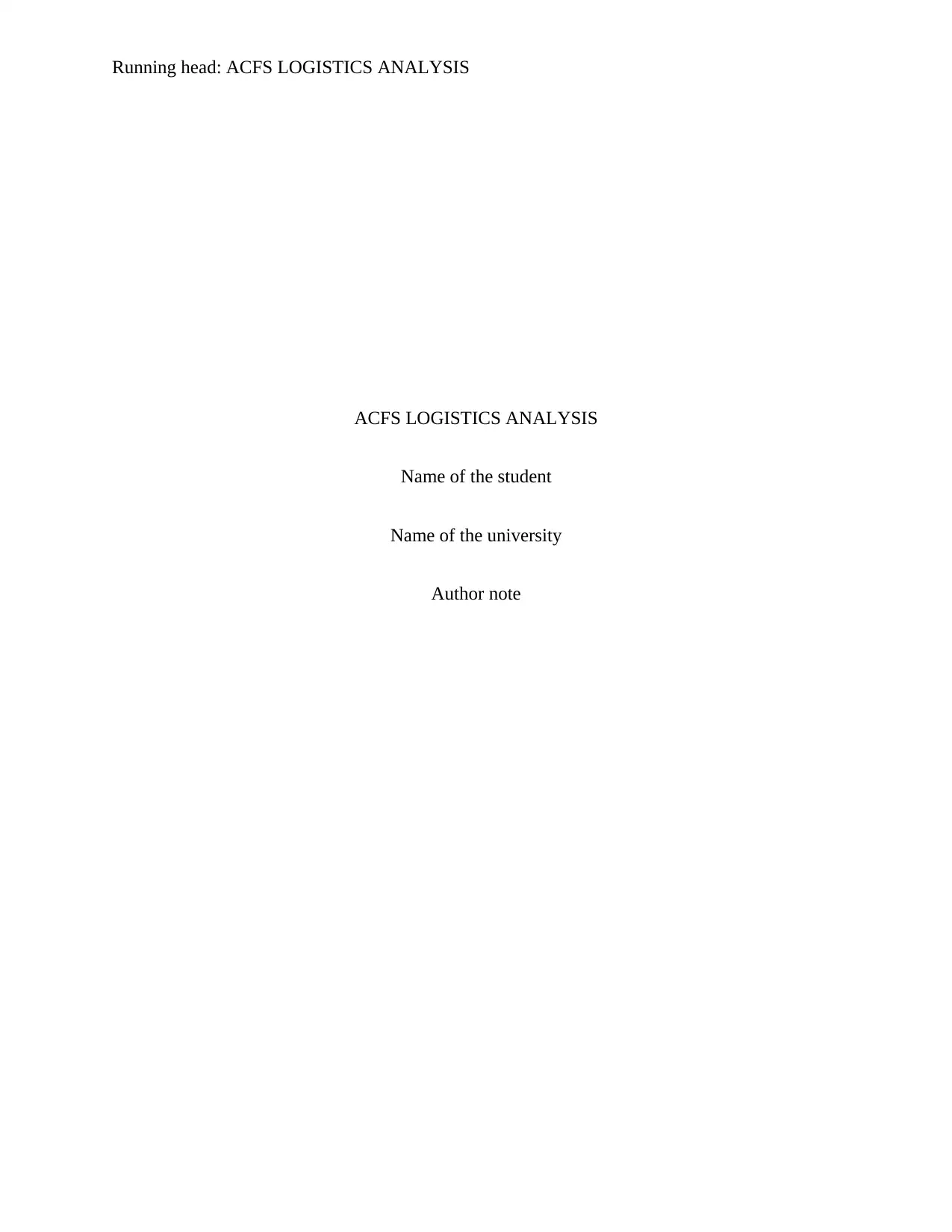
Running head: ACFS LOGISTICS ANALYSIS
ACFS LOGISTICS ANALYSIS
Name of the student
Name of the university
Author note
ACFS LOGISTICS ANALYSIS
Name of the student
Name of the university
Author note
Secure Best Marks with AI Grader
Need help grading? Try our AI Grader for instant feedback on your assignments.
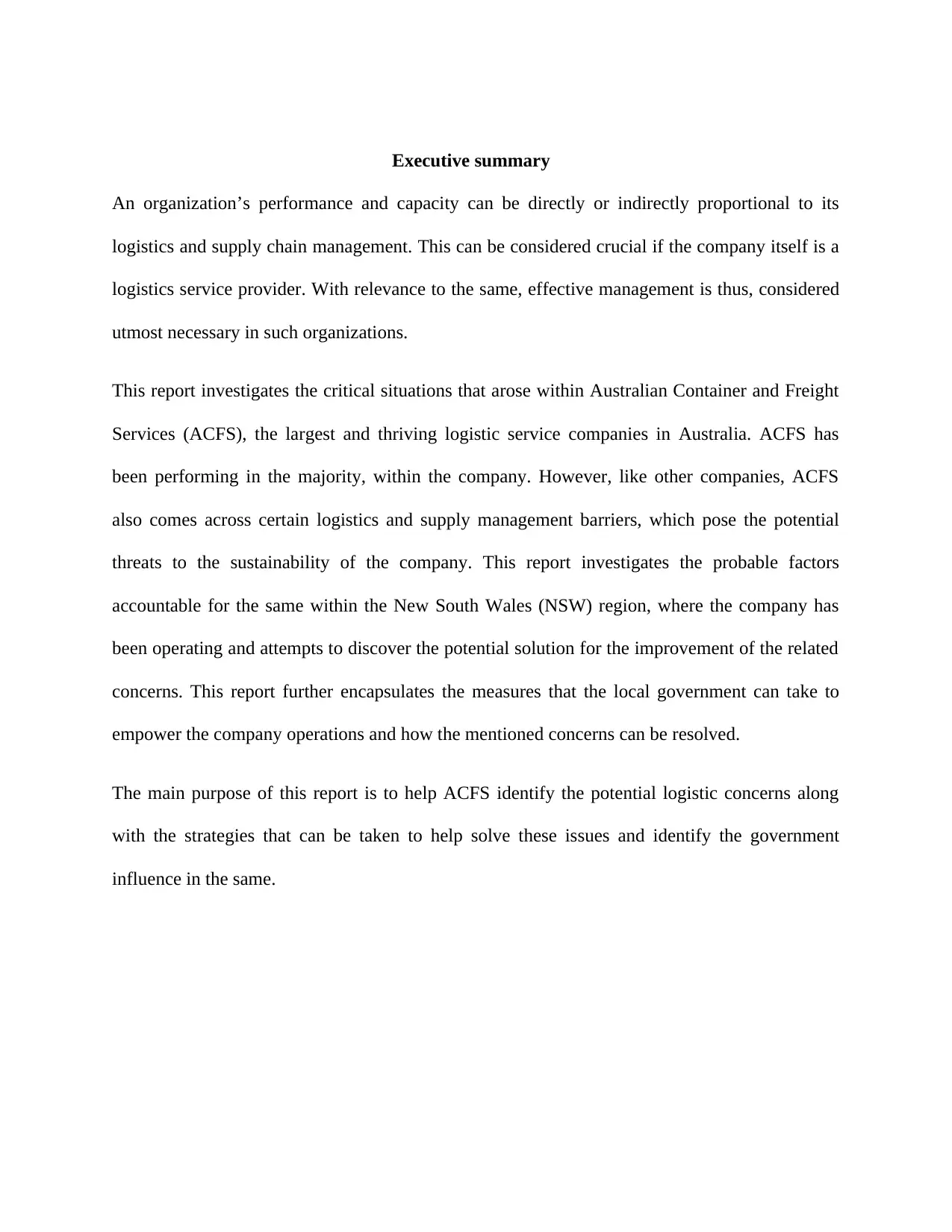
Executive summary
An organization’s performance and capacity can be directly or indirectly proportional to its
logistics and supply chain management. This can be considered crucial if the company itself is a
logistics service provider. With relevance to the same, effective management is thus, considered
utmost necessary in such organizations.
This report investigates the critical situations that arose within Australian Container and Freight
Services (ACFS), the largest and thriving logistic service companies in Australia. ACFS has
been performing in the majority, within the company. However, like other companies, ACFS
also comes across certain logistics and supply management barriers, which pose the potential
threats to the sustainability of the company. This report investigates the probable factors
accountable for the same within the New South Wales (NSW) region, where the company has
been operating and attempts to discover the potential solution for the improvement of the related
concerns. This report further encapsulates the measures that the local government can take to
empower the company operations and how the mentioned concerns can be resolved.
The main purpose of this report is to help ACFS identify the potential logistic concerns along
with the strategies that can be taken to help solve these issues and identify the government
influence in the same.
An organization’s performance and capacity can be directly or indirectly proportional to its
logistics and supply chain management. This can be considered crucial if the company itself is a
logistics service provider. With relevance to the same, effective management is thus, considered
utmost necessary in such organizations.
This report investigates the critical situations that arose within Australian Container and Freight
Services (ACFS), the largest and thriving logistic service companies in Australia. ACFS has
been performing in the majority, within the company. However, like other companies, ACFS
also comes across certain logistics and supply management barriers, which pose the potential
threats to the sustainability of the company. This report investigates the probable factors
accountable for the same within the New South Wales (NSW) region, where the company has
been operating and attempts to discover the potential solution for the improvement of the related
concerns. This report further encapsulates the measures that the local government can take to
empower the company operations and how the mentioned concerns can be resolved.
The main purpose of this report is to help ACFS identify the potential logistic concerns along
with the strategies that can be taken to help solve these issues and identify the government
influence in the same.
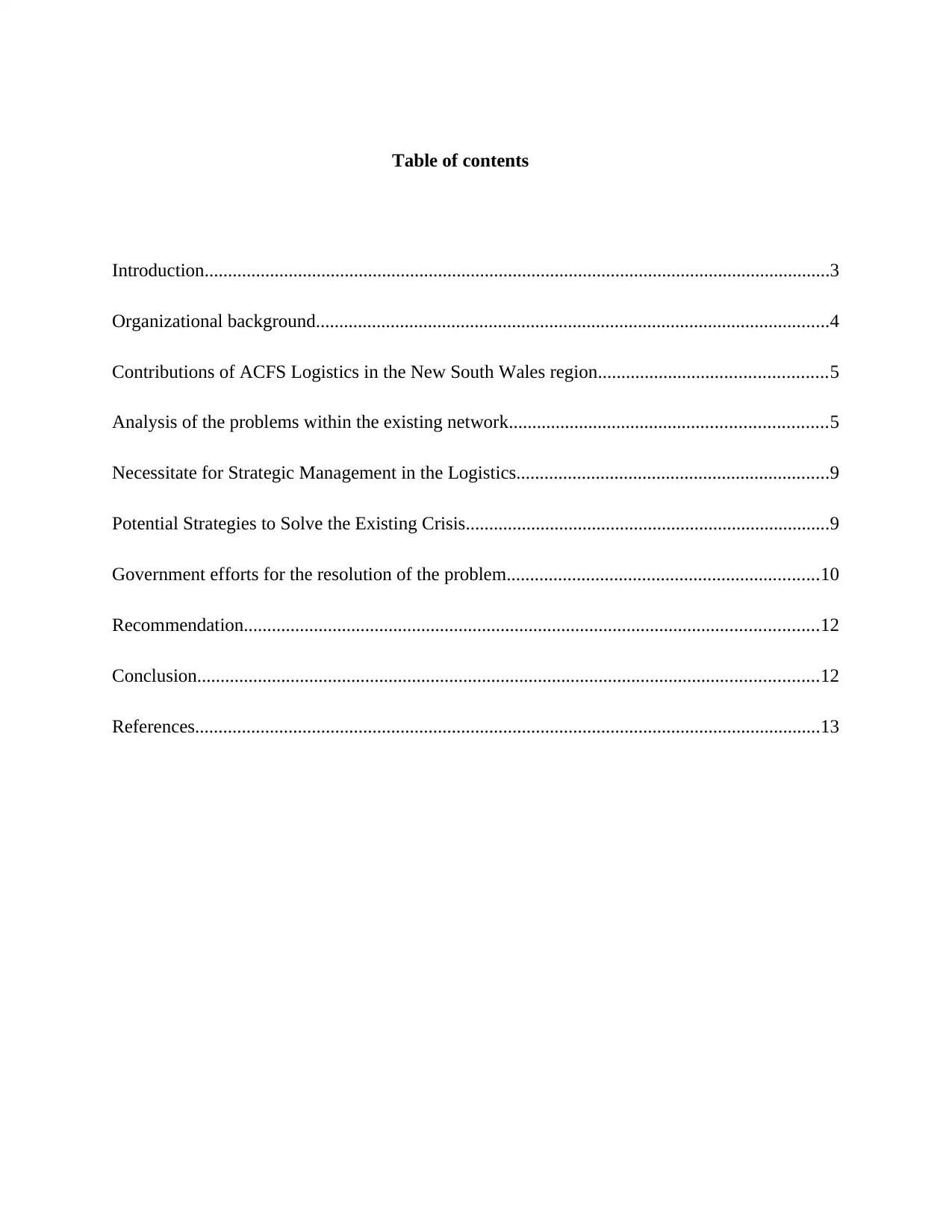
Table of contents
Introduction......................................................................................................................................3
Organizational background..............................................................................................................4
Contributions of ACFS Logistics in the New South Wales region.................................................5
Analysis of the problems within the existing network....................................................................5
Necessitate for Strategic Management in the Logistics...................................................................9
Potential Strategies to Solve the Existing Crisis..............................................................................9
Government efforts for the resolution of the problem...................................................................10
Recommendation...........................................................................................................................12
Conclusion.....................................................................................................................................12
References......................................................................................................................................13
Introduction......................................................................................................................................3
Organizational background..............................................................................................................4
Contributions of ACFS Logistics in the New South Wales region.................................................5
Analysis of the problems within the existing network....................................................................5
Necessitate for Strategic Management in the Logistics...................................................................9
Potential Strategies to Solve the Existing Crisis..............................................................................9
Government efforts for the resolution of the problem...................................................................10
Recommendation...........................................................................................................................12
Conclusion.....................................................................................................................................12
References......................................................................................................................................13
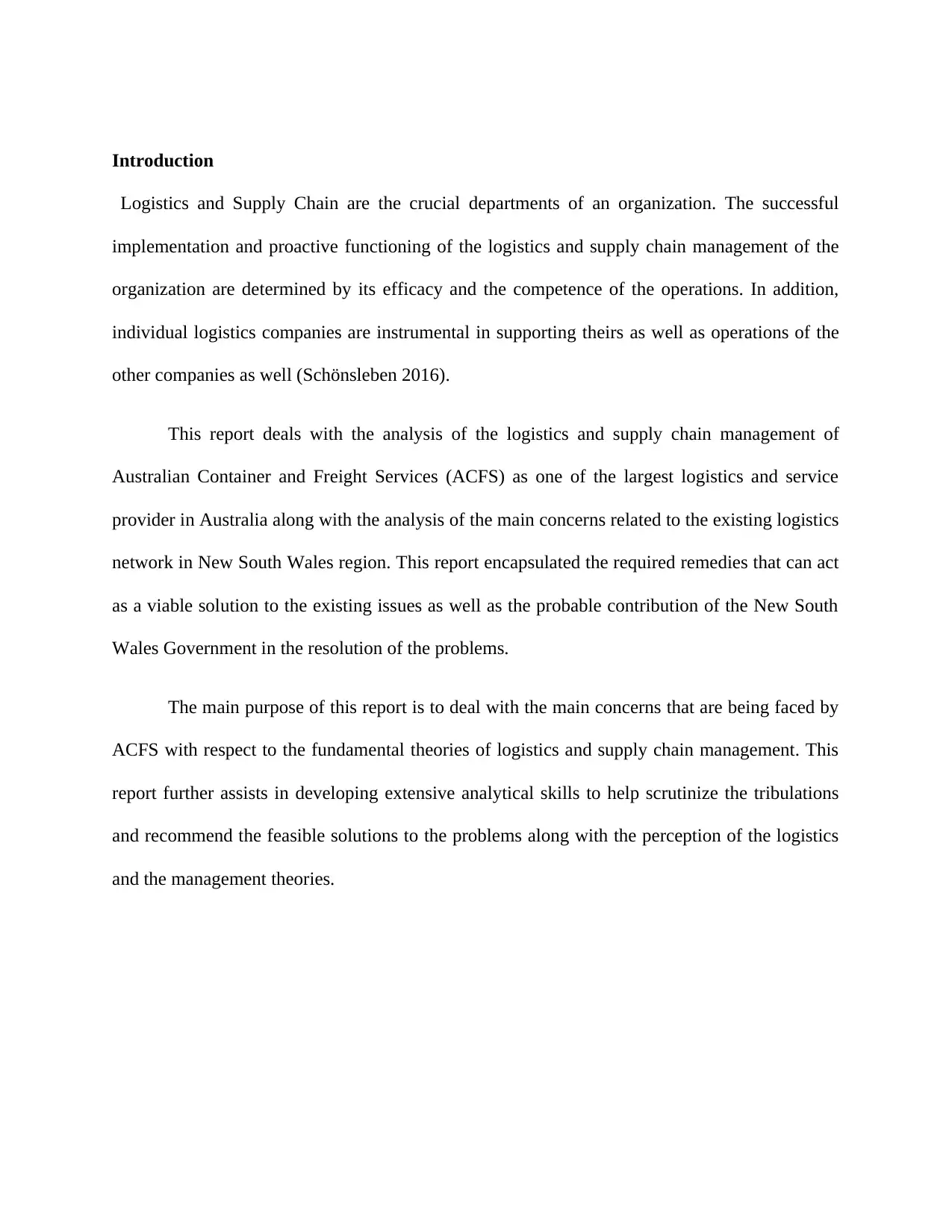
Introduction
Logistics and Supply Chain are the crucial departments of an organization. The successful
implementation and proactive functioning of the logistics and supply chain management of the
organization are determined by its efficacy and the competence of the operations. In addition,
individual logistics companies are instrumental in supporting theirs as well as operations of the
other companies as well (Schönsleben 2016).
This report deals with the analysis of the logistics and supply chain management of
Australian Container and Freight Services (ACFS) as one of the largest logistics and service
provider in Australia along with the analysis of the main concerns related to the existing logistics
network in New South Wales region. This report encapsulated the required remedies that can act
as a viable solution to the existing issues as well as the probable contribution of the New South
Wales Government in the resolution of the problems.
The main purpose of this report is to deal with the main concerns that are being faced by
ACFS with respect to the fundamental theories of logistics and supply chain management. This
report further assists in developing extensive analytical skills to help scrutinize the tribulations
and recommend the feasible solutions to the problems along with the perception of the logistics
and the management theories.
Logistics and Supply Chain are the crucial departments of an organization. The successful
implementation and proactive functioning of the logistics and supply chain management of the
organization are determined by its efficacy and the competence of the operations. In addition,
individual logistics companies are instrumental in supporting theirs as well as operations of the
other companies as well (Schönsleben 2016).
This report deals with the analysis of the logistics and supply chain management of
Australian Container and Freight Services (ACFS) as one of the largest logistics and service
provider in Australia along with the analysis of the main concerns related to the existing logistics
network in New South Wales region. This report encapsulated the required remedies that can act
as a viable solution to the existing issues as well as the probable contribution of the New South
Wales Government in the resolution of the problems.
The main purpose of this report is to deal with the main concerns that are being faced by
ACFS with respect to the fundamental theories of logistics and supply chain management. This
report further assists in developing extensive analytical skills to help scrutinize the tribulations
and recommend the feasible solutions to the problems along with the perception of the logistics
and the management theories.
Secure Best Marks with AI Grader
Need help grading? Try our AI Grader for instant feedback on your assignments.
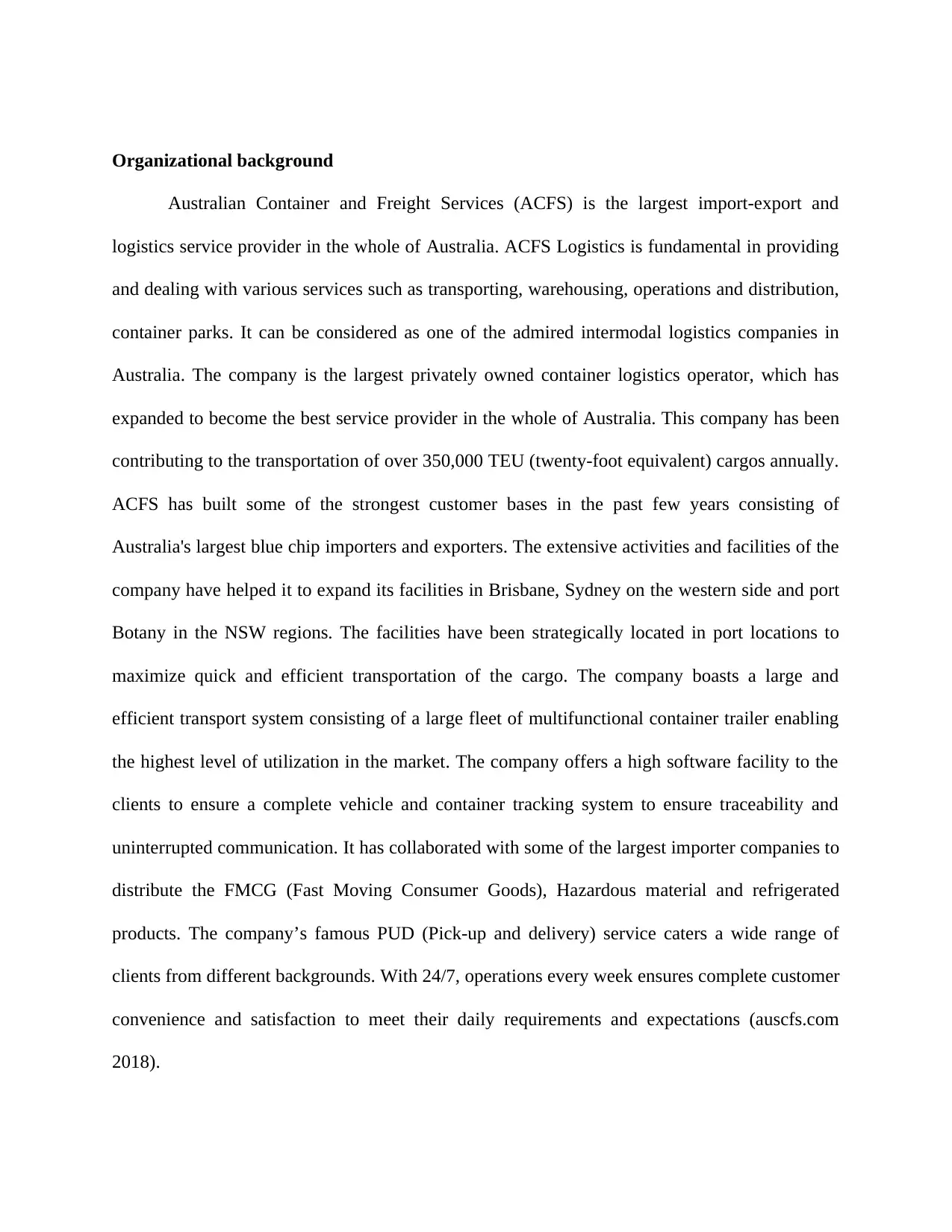
Organizational background
Australian Container and Freight Services (ACFS) is the largest import-export and
logistics service provider in the whole of Australia. ACFS Logistics is fundamental in providing
and dealing with various services such as transporting, warehousing, operations and distribution,
container parks. It can be considered as one of the admired intermodal logistics companies in
Australia. The company is the largest privately owned container logistics operator, which has
expanded to become the best service provider in the whole of Australia. This company has been
contributing to the transportation of over 350,000 TEU (twenty-foot equivalent) cargos annually.
ACFS has built some of the strongest customer bases in the past few years consisting of
Australia's largest blue chip importers and exporters. The extensive activities and facilities of the
company have helped it to expand its facilities in Brisbane, Sydney on the western side and port
Botany in the NSW regions. The facilities have been strategically located in port locations to
maximize quick and efficient transportation of the cargo. The company boasts a large and
efficient transport system consisting of a large fleet of multifunctional container trailer enabling
the highest level of utilization in the market. The company offers a high software facility to the
clients to ensure a complete vehicle and container tracking system to ensure traceability and
uninterrupted communication. It has collaborated with some of the largest importer companies to
distribute the FMCG (Fast Moving Consumer Goods), Hazardous material and refrigerated
products. The company’s famous PUD (Pick-up and delivery) service caters a wide range of
clients from different backgrounds. With 24/7, operations every week ensures complete customer
convenience and satisfaction to meet their daily requirements and expectations (auscfs.com
2018).
Australian Container and Freight Services (ACFS) is the largest import-export and
logistics service provider in the whole of Australia. ACFS Logistics is fundamental in providing
and dealing with various services such as transporting, warehousing, operations and distribution,
container parks. It can be considered as one of the admired intermodal logistics companies in
Australia. The company is the largest privately owned container logistics operator, which has
expanded to become the best service provider in the whole of Australia. This company has been
contributing to the transportation of over 350,000 TEU (twenty-foot equivalent) cargos annually.
ACFS has built some of the strongest customer bases in the past few years consisting of
Australia's largest blue chip importers and exporters. The extensive activities and facilities of the
company have helped it to expand its facilities in Brisbane, Sydney on the western side and port
Botany in the NSW regions. The facilities have been strategically located in port locations to
maximize quick and efficient transportation of the cargo. The company boasts a large and
efficient transport system consisting of a large fleet of multifunctional container trailer enabling
the highest level of utilization in the market. The company offers a high software facility to the
clients to ensure a complete vehicle and container tracking system to ensure traceability and
uninterrupted communication. It has collaborated with some of the largest importer companies to
distribute the FMCG (Fast Moving Consumer Goods), Hazardous material and refrigerated
products. The company’s famous PUD (Pick-up and delivery) service caters a wide range of
clients from different backgrounds. With 24/7, operations every week ensures complete customer
convenience and satisfaction to meet their daily requirements and expectations (auscfs.com
2018).

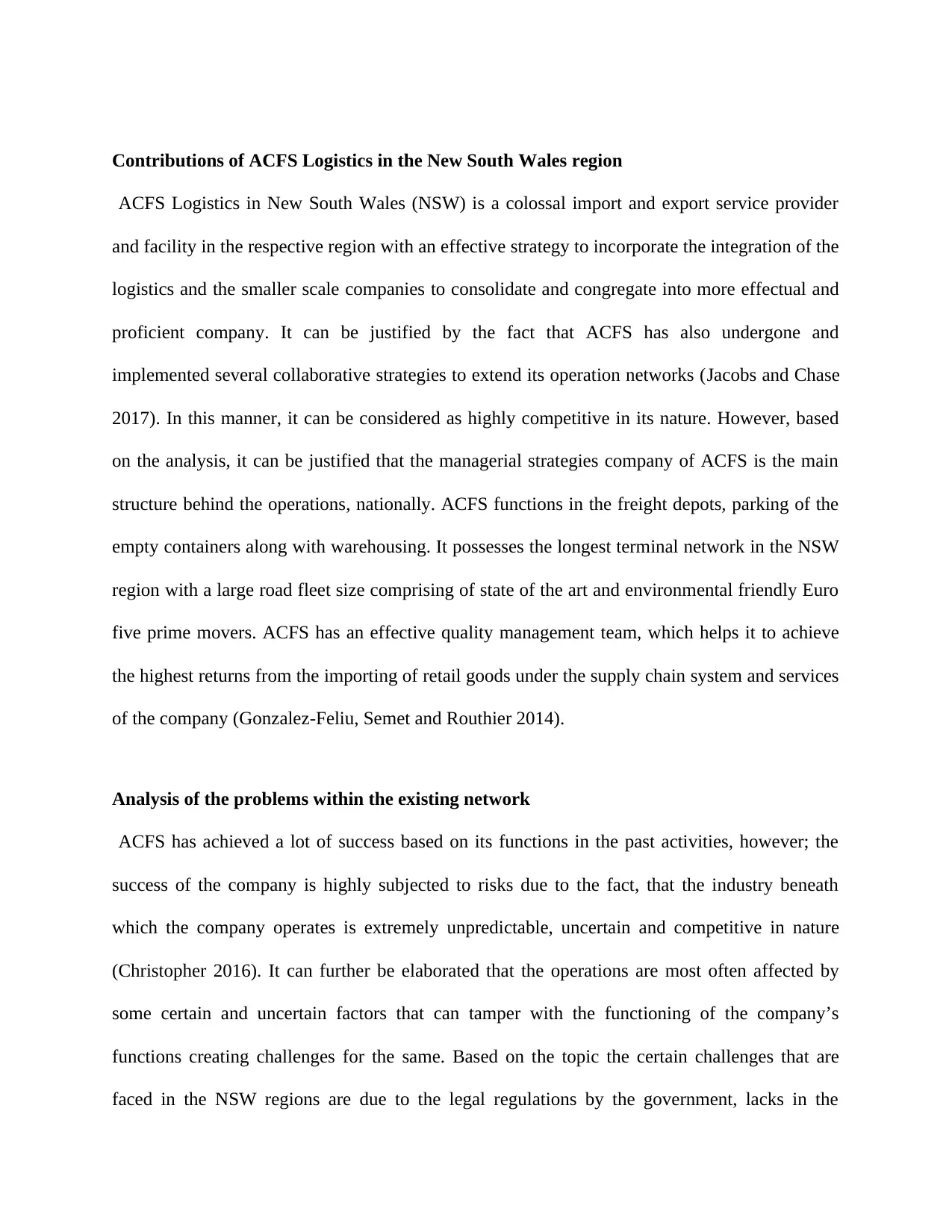
Contributions of ACFS Logistics in the New South Wales region
ACFS Logistics in New South Wales (NSW) is a colossal import and export service provider
and facility in the respective region with an effective strategy to incorporate the integration of the
logistics and the smaller scale companies to consolidate and congregate into more effectual and
proficient company. It can be justified by the fact that ACFS has also undergone and
implemented several collaborative strategies to extend its operation networks (Jacobs and Chase
2017). In this manner, it can be considered as highly competitive in its nature. However, based
on the analysis, it can be justified that the managerial strategies company of ACFS is the main
structure behind the operations, nationally. ACFS functions in the freight depots, parking of the
empty containers along with warehousing. It possesses the longest terminal network in the NSW
region with a large road fleet size comprising of state of the art and environmental friendly Euro
five prime movers. ACFS has an effective quality management team, which helps it to achieve
the highest returns from the importing of retail goods under the supply chain system and services
of the company (Gonzalez-Feliu, Semet and Routhier 2014).
Analysis of the problems within the existing network
ACFS has achieved a lot of success based on its functions in the past activities, however; the
success of the company is highly subjected to risks due to the fact, that the industry beneath
which the company operates is extremely unpredictable, uncertain and competitive in nature
(Christopher 2016). It can further be elaborated that the operations are most often affected by
some certain and uncertain factors that can tamper with the functioning of the company’s
functions creating challenges for the same. Based on the topic the certain challenges that are
faced in the NSW regions are due to the legal regulations by the government, lacks in the
ACFS Logistics in New South Wales (NSW) is a colossal import and export service provider
and facility in the respective region with an effective strategy to incorporate the integration of the
logistics and the smaller scale companies to consolidate and congregate into more effectual and
proficient company. It can be justified by the fact that ACFS has also undergone and
implemented several collaborative strategies to extend its operation networks (Jacobs and Chase
2017). In this manner, it can be considered as highly competitive in its nature. However, based
on the analysis, it can be justified that the managerial strategies company of ACFS is the main
structure behind the operations, nationally. ACFS functions in the freight depots, parking of the
empty containers along with warehousing. It possesses the longest terminal network in the NSW
region with a large road fleet size comprising of state of the art and environmental friendly Euro
five prime movers. ACFS has an effective quality management team, which helps it to achieve
the highest returns from the importing of retail goods under the supply chain system and services
of the company (Gonzalez-Feliu, Semet and Routhier 2014).
Analysis of the problems within the existing network
ACFS has achieved a lot of success based on its functions in the past activities, however; the
success of the company is highly subjected to risks due to the fact, that the industry beneath
which the company operates is extremely unpredictable, uncertain and competitive in nature
(Christopher 2016). It can further be elaborated that the operations are most often affected by
some certain and uncertain factors that can tamper with the functioning of the company’s
functions creating challenges for the same. Based on the topic the certain challenges that are
faced in the NSW regions are due to the legal regulations by the government, lacks in the
Paraphrase This Document
Need a fresh take? Get an instant paraphrase of this document with our AI Paraphraser
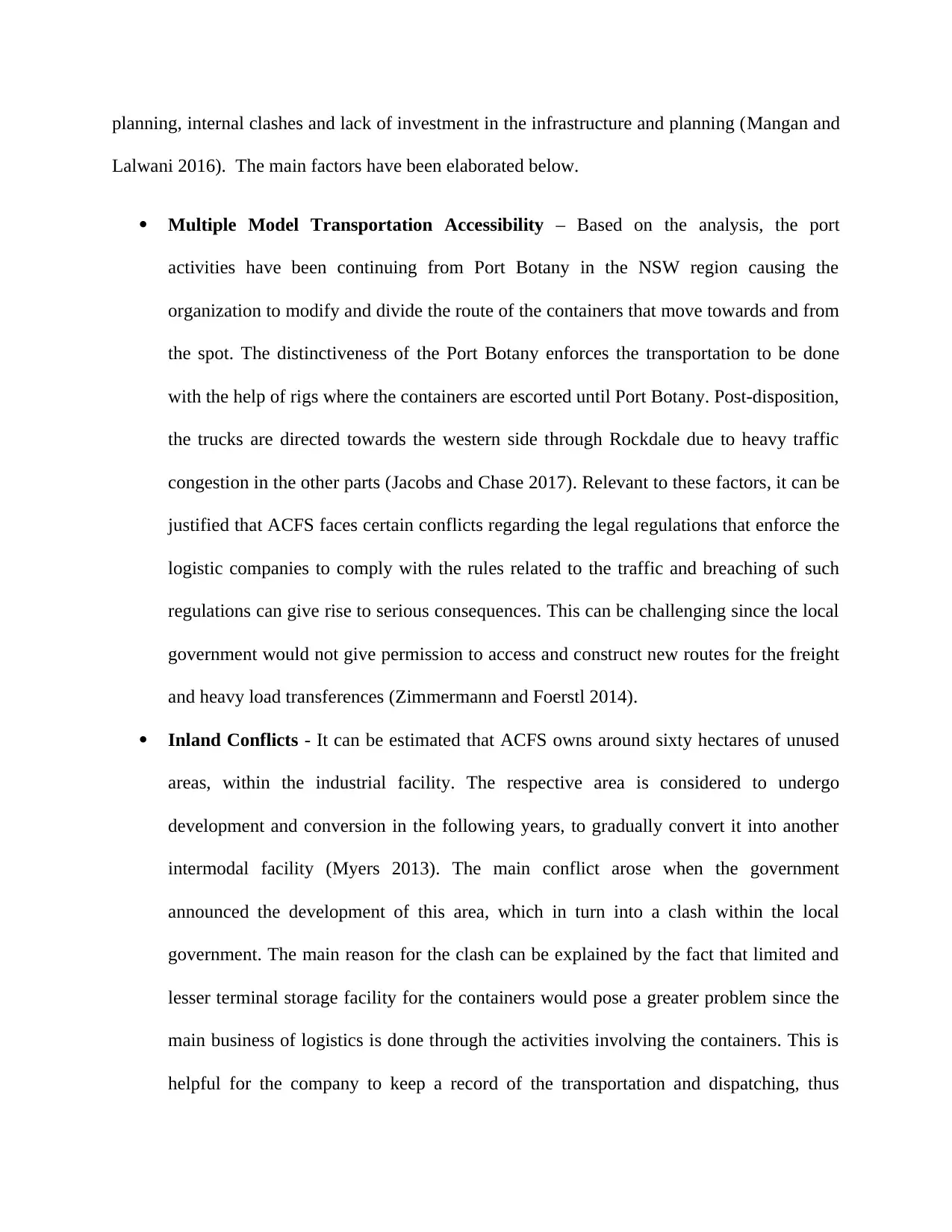
planning, internal clashes and lack of investment in the infrastructure and planning (Mangan and
Lalwani 2016). The main factors have been elaborated below.
Multiple Model Transportation Accessibility – Based on the analysis, the port
activities have been continuing from Port Botany in the NSW region causing the
organization to modify and divide the route of the containers that move towards and from
the spot. The distinctiveness of the Port Botany enforces the transportation to be done
with the help of rigs where the containers are escorted until Port Botany. Post-disposition,
the trucks are directed towards the western side through Rockdale due to heavy traffic
congestion in the other parts (Jacobs and Chase 2017). Relevant to these factors, it can be
justified that ACFS faces certain conflicts regarding the legal regulations that enforce the
logistic companies to comply with the rules related to the traffic and breaching of such
regulations can give rise to serious consequences. This can be challenging since the local
government would not give permission to access and construct new routes for the freight
and heavy load transferences (Zimmermann and Foerstl 2014).
Inland Conflicts - It can be estimated that ACFS owns around sixty hectares of unused
areas, within the industrial facility. The respective area is considered to undergo
development and conversion in the following years, to gradually convert it into another
intermodal facility (Myers 2013). The main conflict arose when the government
announced the development of this area, which in turn into a clash within the local
government. The main reason for the clash can be explained by the fact that limited and
lesser terminal storage facility for the containers would pose a greater problem since the
main business of logistics is done through the activities involving the containers. This is
helpful for the company to keep a record of the transportation and dispatching, thus
Lalwani 2016). The main factors have been elaborated below.
Multiple Model Transportation Accessibility – Based on the analysis, the port
activities have been continuing from Port Botany in the NSW region causing the
organization to modify and divide the route of the containers that move towards and from
the spot. The distinctiveness of the Port Botany enforces the transportation to be done
with the help of rigs where the containers are escorted until Port Botany. Post-disposition,
the trucks are directed towards the western side through Rockdale due to heavy traffic
congestion in the other parts (Jacobs and Chase 2017). Relevant to these factors, it can be
justified that ACFS faces certain conflicts regarding the legal regulations that enforce the
logistic companies to comply with the rules related to the traffic and breaching of such
regulations can give rise to serious consequences. This can be challenging since the local
government would not give permission to access and construct new routes for the freight
and heavy load transferences (Zimmermann and Foerstl 2014).
Inland Conflicts - It can be estimated that ACFS owns around sixty hectares of unused
areas, within the industrial facility. The respective area is considered to undergo
development and conversion in the following years, to gradually convert it into another
intermodal facility (Myers 2013). The main conflict arose when the government
announced the development of this area, which in turn into a clash within the local
government. The main reason for the clash can be explained by the fact that limited and
lesser terminal storage facility for the containers would pose a greater problem since the
main business of logistics is done through the activities involving the containers. This is
helpful for the company to keep a record of the transportation and dispatching, thus
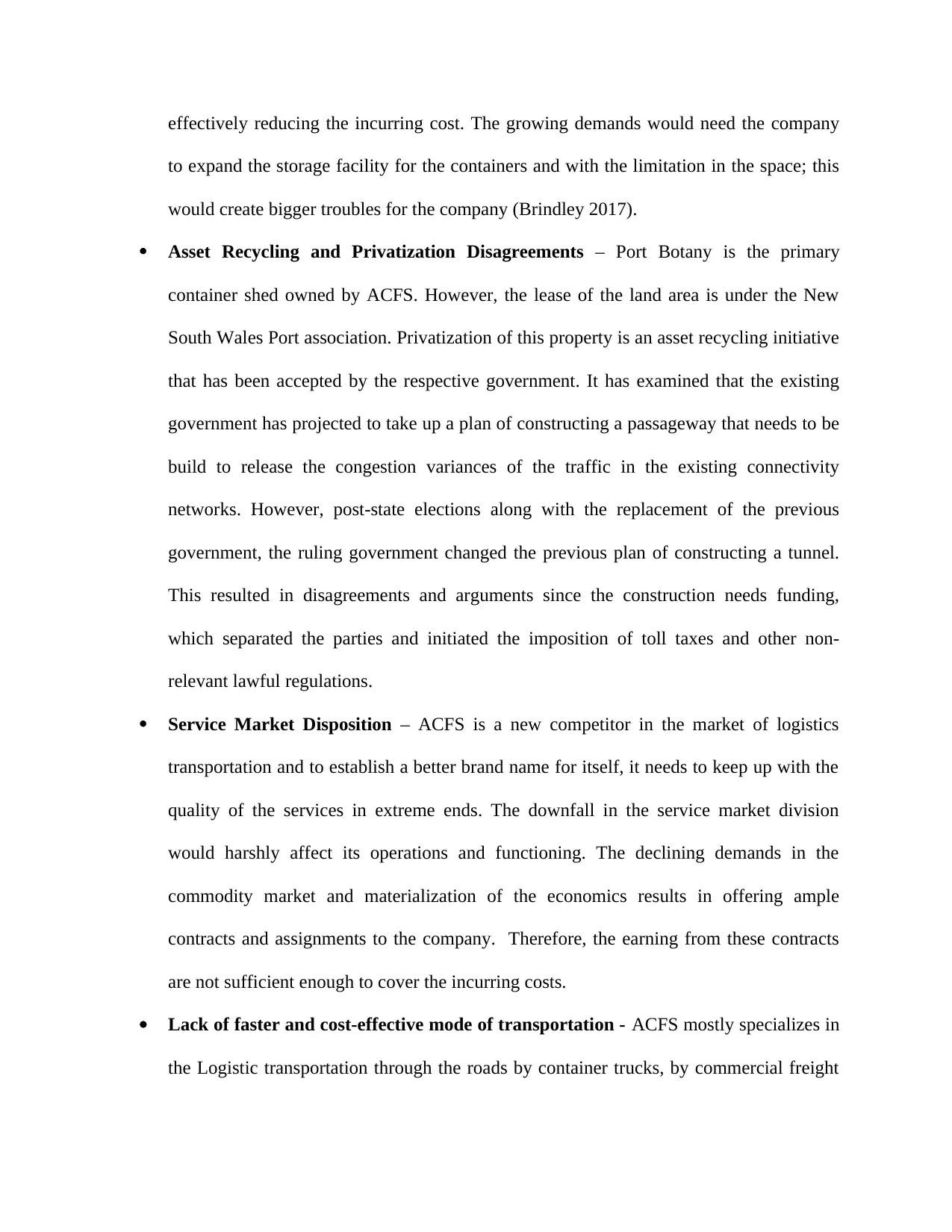
effectively reducing the incurring cost. The growing demands would need the company
to expand the storage facility for the containers and with the limitation in the space; this
would create bigger troubles for the company (Brindley 2017).
Asset Recycling and Privatization Disagreements – Port Botany is the primary
container shed owned by ACFS. However, the lease of the land area is under the New
South Wales Port association. Privatization of this property is an asset recycling initiative
that has been accepted by the respective government. It has examined that the existing
government has projected to take up a plan of constructing a passageway that needs to be
build to release the congestion variances of the traffic in the existing connectivity
networks. However, post-state elections along with the replacement of the previous
government, the ruling government changed the previous plan of constructing a tunnel.
This resulted in disagreements and arguments since the construction needs funding,
which separated the parties and initiated the imposition of toll taxes and other non-
relevant lawful regulations.
Service Market Disposition – ACFS is a new competitor in the market of logistics
transportation and to establish a better brand name for itself, it needs to keep up with the
quality of the services in extreme ends. The downfall in the service market division
would harshly affect its operations and functioning. The declining demands in the
commodity market and materialization of the economics results in offering ample
contracts and assignments to the company. Therefore, the earning from these contracts
are not sufficient enough to cover the incurring costs.
Lack of faster and cost-effective mode of transportation - ACFS mostly specializes in
the Logistic transportation through the roads by container trucks, by commercial freight
to expand the storage facility for the containers and with the limitation in the space; this
would create bigger troubles for the company (Brindley 2017).
Asset Recycling and Privatization Disagreements – Port Botany is the primary
container shed owned by ACFS. However, the lease of the land area is under the New
South Wales Port association. Privatization of this property is an asset recycling initiative
that has been accepted by the respective government. It has examined that the existing
government has projected to take up a plan of constructing a passageway that needs to be
build to release the congestion variances of the traffic in the existing connectivity
networks. However, post-state elections along with the replacement of the previous
government, the ruling government changed the previous plan of constructing a tunnel.
This resulted in disagreements and arguments since the construction needs funding,
which separated the parties and initiated the imposition of toll taxes and other non-
relevant lawful regulations.
Service Market Disposition – ACFS is a new competitor in the market of logistics
transportation and to establish a better brand name for itself, it needs to keep up with the
quality of the services in extreme ends. The downfall in the service market division
would harshly affect its operations and functioning. The declining demands in the
commodity market and materialization of the economics results in offering ample
contracts and assignments to the company. Therefore, the earning from these contracts
are not sufficient enough to cover the incurring costs.
Lack of faster and cost-effective mode of transportation - ACFS mostly specializes in
the Logistic transportation through the roads by container trucks, by commercial freight
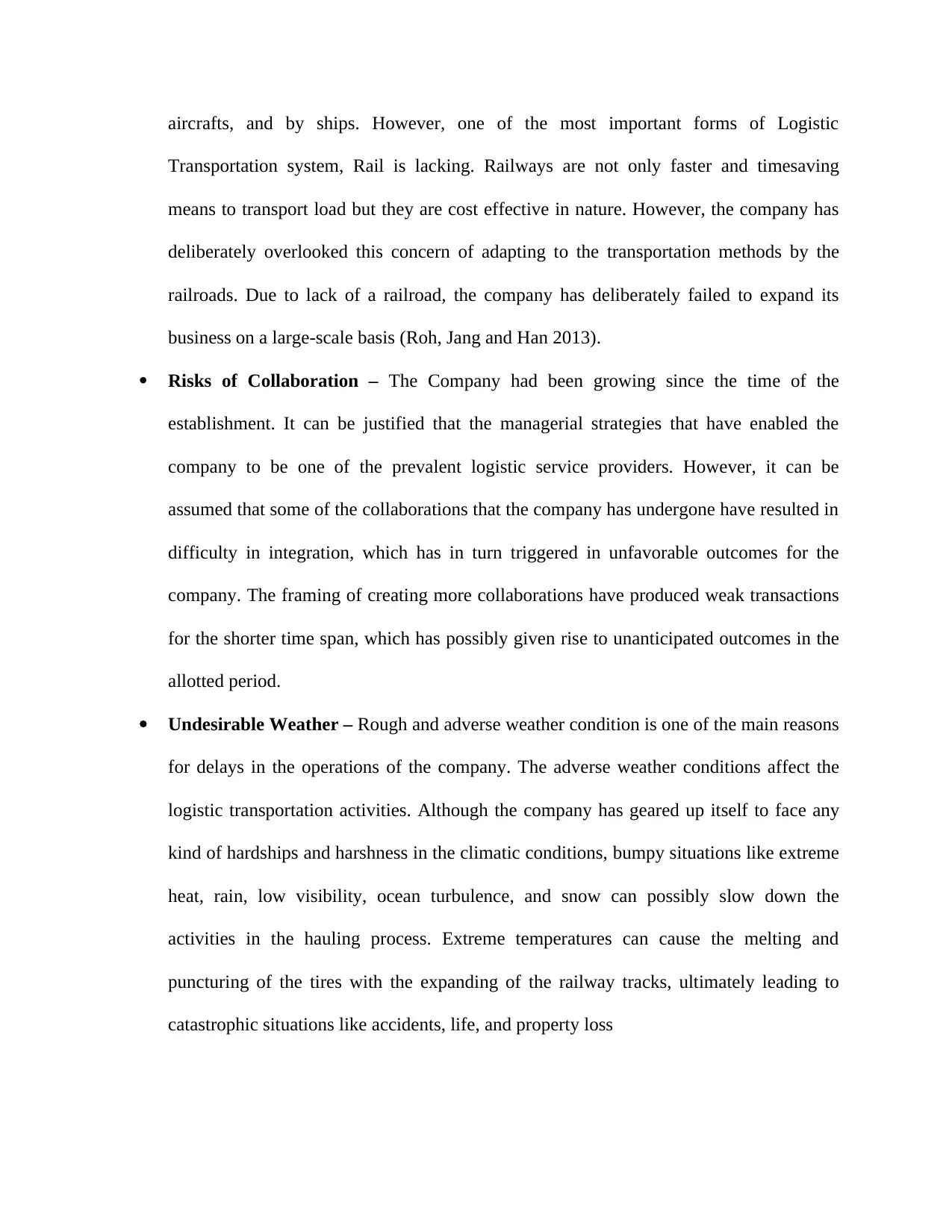
aircrafts, and by ships. However, one of the most important forms of Logistic
Transportation system, Rail is lacking. Railways are not only faster and timesaving
means to transport load but they are cost effective in nature. However, the company has
deliberately overlooked this concern of adapting to the transportation methods by the
railroads. Due to lack of a railroad, the company has deliberately failed to expand its
business on a large-scale basis (Roh, Jang and Han 2013).
Risks of Collaboration – The Company had been growing since the time of the
establishment. It can be justified that the managerial strategies that have enabled the
company to be one of the prevalent logistic service providers. However, it can be
assumed that some of the collaborations that the company has undergone have resulted in
difficulty in integration, which has in turn triggered in unfavorable outcomes for the
company. The framing of creating more collaborations have produced weak transactions
for the shorter time span, which has possibly given rise to unanticipated outcomes in the
allotted period.
Undesirable Weather – Rough and adverse weather condition is one of the main reasons
for delays in the operations of the company. The adverse weather conditions affect the
logistic transportation activities. Although the company has geared up itself to face any
kind of hardships and harshness in the climatic conditions, bumpy situations like extreme
heat, rain, low visibility, ocean turbulence, and snow can possibly slow down the
activities in the hauling process. Extreme temperatures can cause the melting and
puncturing of the tires with the expanding of the railway tracks, ultimately leading to
catastrophic situations like accidents, life, and property loss
Transportation system, Rail is lacking. Railways are not only faster and timesaving
means to transport load but they are cost effective in nature. However, the company has
deliberately overlooked this concern of adapting to the transportation methods by the
railroads. Due to lack of a railroad, the company has deliberately failed to expand its
business on a large-scale basis (Roh, Jang and Han 2013).
Risks of Collaboration – The Company had been growing since the time of the
establishment. It can be justified that the managerial strategies that have enabled the
company to be one of the prevalent logistic service providers. However, it can be
assumed that some of the collaborations that the company has undergone have resulted in
difficulty in integration, which has in turn triggered in unfavorable outcomes for the
company. The framing of creating more collaborations have produced weak transactions
for the shorter time span, which has possibly given rise to unanticipated outcomes in the
allotted period.
Undesirable Weather – Rough and adverse weather condition is one of the main reasons
for delays in the operations of the company. The adverse weather conditions affect the
logistic transportation activities. Although the company has geared up itself to face any
kind of hardships and harshness in the climatic conditions, bumpy situations like extreme
heat, rain, low visibility, ocean turbulence, and snow can possibly slow down the
activities in the hauling process. Extreme temperatures can cause the melting and
puncturing of the tires with the expanding of the railway tracks, ultimately leading to
catastrophic situations like accidents, life, and property loss
Secure Best Marks with AI Grader
Need help grading? Try our AI Grader for instant feedback on your assignments.
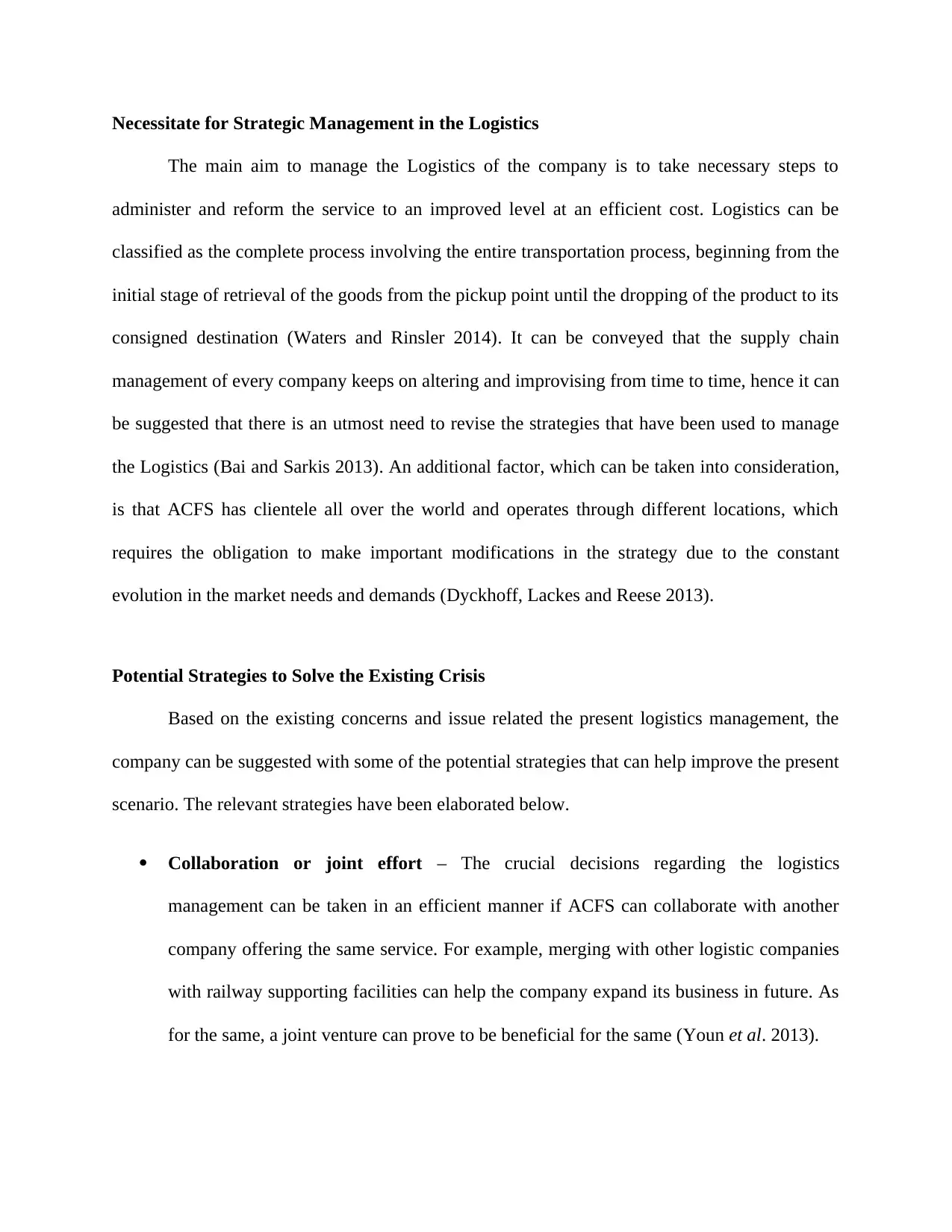
Necessitate for Strategic Management in the Logistics
The main aim to manage the Logistics of the company is to take necessary steps to
administer and reform the service to an improved level at an efficient cost. Logistics can be
classified as the complete process involving the entire transportation process, beginning from the
initial stage of retrieval of the goods from the pickup point until the dropping of the product to its
consigned destination (Waters and Rinsler 2014). It can be conveyed that the supply chain
management of every company keeps on altering and improvising from time to time, hence it can
be suggested that there is an utmost need to revise the strategies that have been used to manage
the Logistics (Bai and Sarkis 2013). An additional factor, which can be taken into consideration,
is that ACFS has clientele all over the world and operates through different locations, which
requires the obligation to make important modifications in the strategy due to the constant
evolution in the market needs and demands (Dyckhoff, Lackes and Reese 2013).
Potential Strategies to Solve the Existing Crisis
Based on the existing concerns and issue related the present logistics management, the
company can be suggested with some of the potential strategies that can help improve the present
scenario. The relevant strategies have been elaborated below.
Collaboration or joint effort – The crucial decisions regarding the logistics
management can be taken in an efficient manner if ACFS can collaborate with another
company offering the same service. For example, merging with other logistic companies
with railway supporting facilities can help the company expand its business in future. As
for the same, a joint venture can prove to be beneficial for the same (Youn et al. 2013).
The main aim to manage the Logistics of the company is to take necessary steps to
administer and reform the service to an improved level at an efficient cost. Logistics can be
classified as the complete process involving the entire transportation process, beginning from the
initial stage of retrieval of the goods from the pickup point until the dropping of the product to its
consigned destination (Waters and Rinsler 2014). It can be conveyed that the supply chain
management of every company keeps on altering and improvising from time to time, hence it can
be suggested that there is an utmost need to revise the strategies that have been used to manage
the Logistics (Bai and Sarkis 2013). An additional factor, which can be taken into consideration,
is that ACFS has clientele all over the world and operates through different locations, which
requires the obligation to make important modifications in the strategy due to the constant
evolution in the market needs and demands (Dyckhoff, Lackes and Reese 2013).
Potential Strategies to Solve the Existing Crisis
Based on the existing concerns and issue related the present logistics management, the
company can be suggested with some of the potential strategies that can help improve the present
scenario. The relevant strategies have been elaborated below.
Collaboration or joint effort – The crucial decisions regarding the logistics
management can be taken in an efficient manner if ACFS can collaborate with another
company offering the same service. For example, merging with other logistic companies
with railway supporting facilities can help the company expand its business in future. As
for the same, a joint venture can prove to be beneficial for the same (Youn et al. 2013).
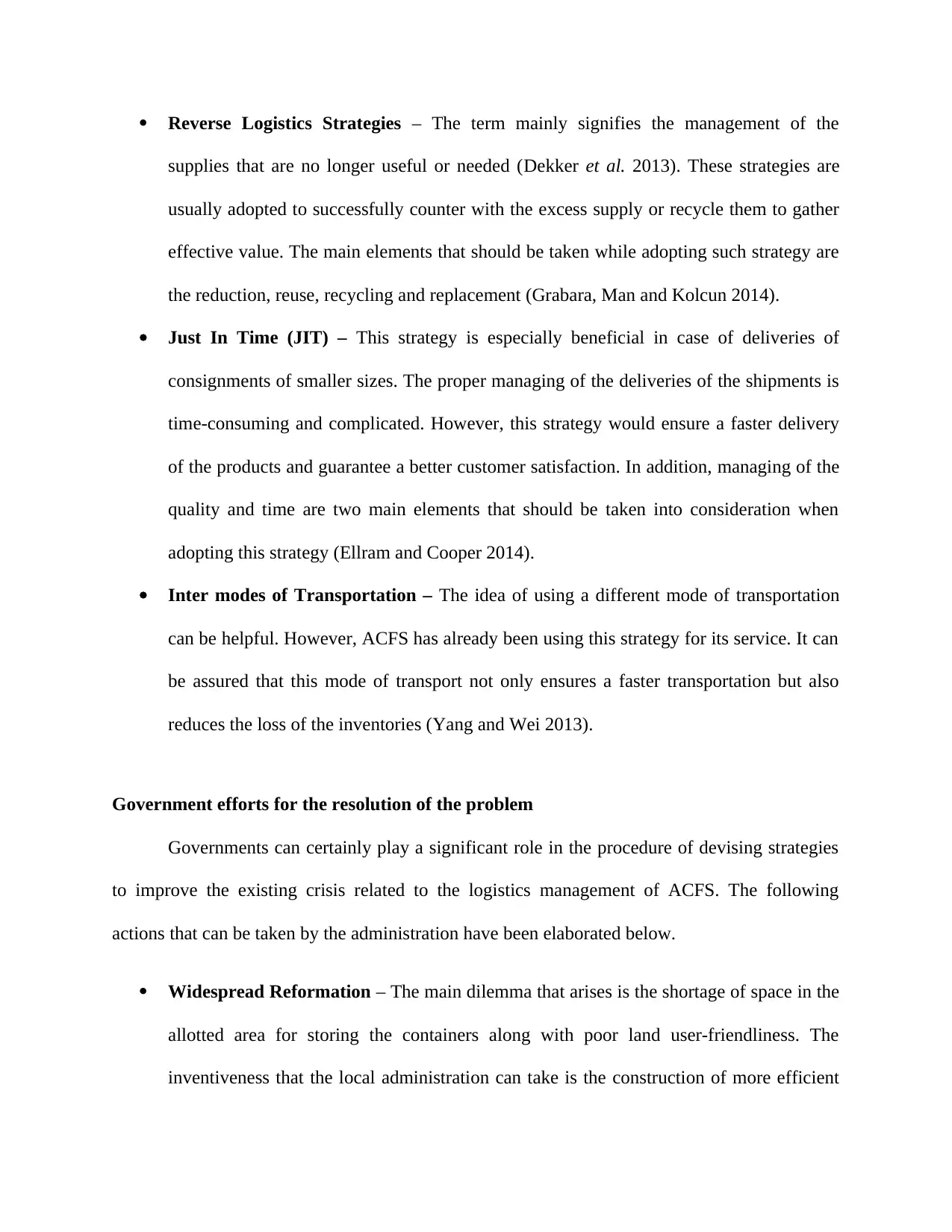
Reverse Logistics Strategies – The term mainly signifies the management of the
supplies that are no longer useful or needed (Dekker et al. 2013). These strategies are
usually adopted to successfully counter with the excess supply or recycle them to gather
effective value. The main elements that should be taken while adopting such strategy are
the reduction, reuse, recycling and replacement (Grabara, Man and Kolcun 2014).
Just In Time (JIT) – This strategy is especially beneficial in case of deliveries of
consignments of smaller sizes. The proper managing of the deliveries of the shipments is
time-consuming and complicated. However, this strategy would ensure a faster delivery
of the products and guarantee a better customer satisfaction. In addition, managing of the
quality and time are two main elements that should be taken into consideration when
adopting this strategy (Ellram and Cooper 2014).
Inter modes of Transportation – The idea of using a different mode of transportation
can be helpful. However, ACFS has already been using this strategy for its service. It can
be assured that this mode of transport not only ensures a faster transportation but also
reduces the loss of the inventories (Yang and Wei 2013).
Government efforts for the resolution of the problem
Governments can certainly play a significant role in the procedure of devising strategies
to improve the existing crisis related to the logistics management of ACFS. The following
actions that can be taken by the administration have been elaborated below.
Widespread Reformation – The main dilemma that arises is the shortage of space in the
allotted area for storing the containers along with poor land user-friendliness. The
inventiveness that the local administration can take is the construction of more efficient
supplies that are no longer useful or needed (Dekker et al. 2013). These strategies are
usually adopted to successfully counter with the excess supply or recycle them to gather
effective value. The main elements that should be taken while adopting such strategy are
the reduction, reuse, recycling and replacement (Grabara, Man and Kolcun 2014).
Just In Time (JIT) – This strategy is especially beneficial in case of deliveries of
consignments of smaller sizes. The proper managing of the deliveries of the shipments is
time-consuming and complicated. However, this strategy would ensure a faster delivery
of the products and guarantee a better customer satisfaction. In addition, managing of the
quality and time are two main elements that should be taken into consideration when
adopting this strategy (Ellram and Cooper 2014).
Inter modes of Transportation – The idea of using a different mode of transportation
can be helpful. However, ACFS has already been using this strategy for its service. It can
be assured that this mode of transport not only ensures a faster transportation but also
reduces the loss of the inventories (Yang and Wei 2013).
Government efforts for the resolution of the problem
Governments can certainly play a significant role in the procedure of devising strategies
to improve the existing crisis related to the logistics management of ACFS. The following
actions that can be taken by the administration have been elaborated below.
Widespread Reformation – The main dilemma that arises is the shortage of space in the
allotted area for storing the containers along with poor land user-friendliness. The
inventiveness that the local administration can take is the construction of more efficient
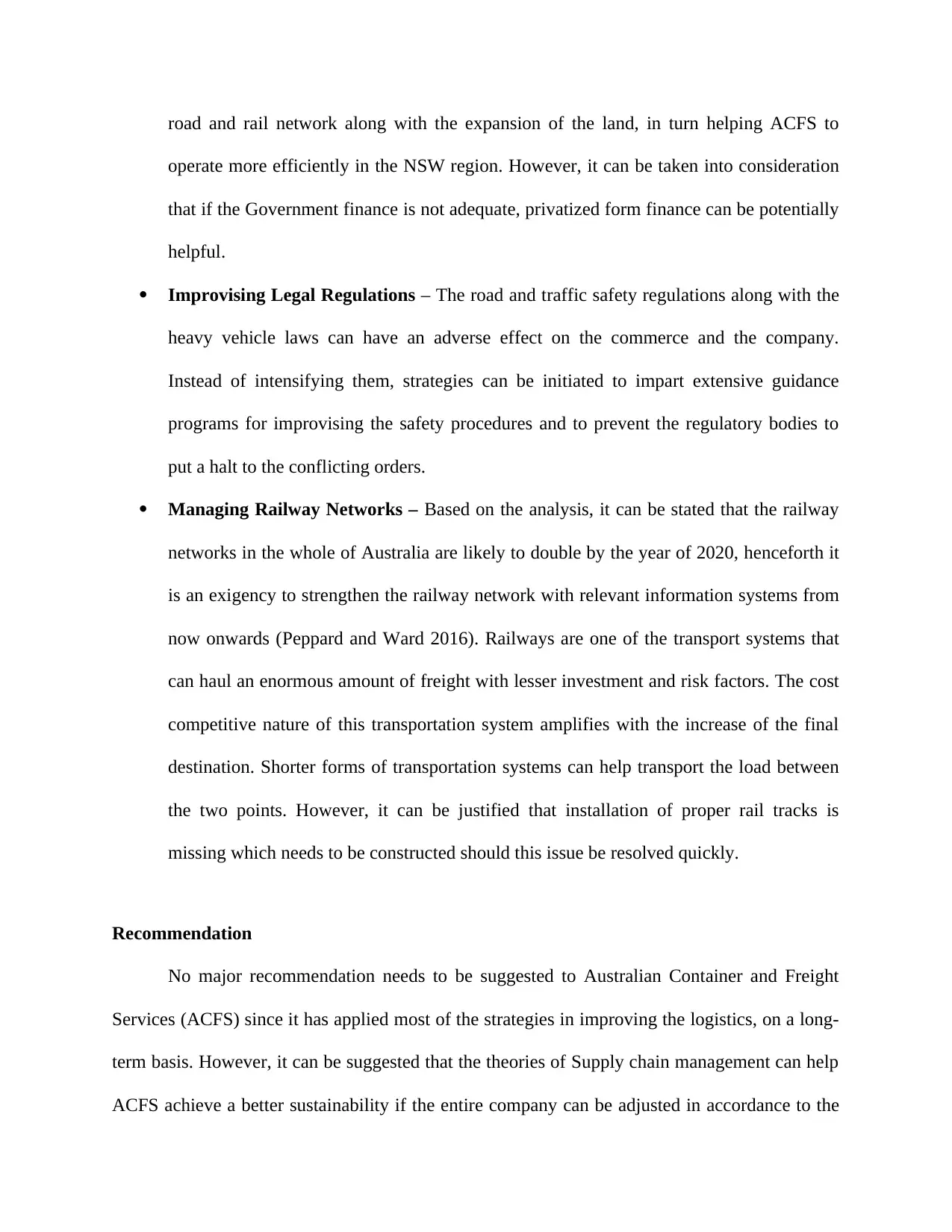
road and rail network along with the expansion of the land, in turn helping ACFS to
operate more efficiently in the NSW region. However, it can be taken into consideration
that if the Government finance is not adequate, privatized form finance can be potentially
helpful.
Improvising Legal Regulations – The road and traffic safety regulations along with the
heavy vehicle laws can have an adverse effect on the commerce and the company.
Instead of intensifying them, strategies can be initiated to impart extensive guidance
programs for improvising the safety procedures and to prevent the regulatory bodies to
put a halt to the conflicting orders.
Managing Railway Networks – Based on the analysis, it can be stated that the railway
networks in the whole of Australia are likely to double by the year of 2020, henceforth it
is an exigency to strengthen the railway network with relevant information systems from
now onwards (Peppard and Ward 2016). Railways are one of the transport systems that
can haul an enormous amount of freight with lesser investment and risk factors. The cost
competitive nature of this transportation system amplifies with the increase of the final
destination. Shorter forms of transportation systems can help transport the load between
the two points. However, it can be justified that installation of proper rail tracks is
missing which needs to be constructed should this issue be resolved quickly.
Recommendation
No major recommendation needs to be suggested to Australian Container and Freight
Services (ACFS) since it has applied most of the strategies in improving the logistics, on a long-
term basis. However, it can be suggested that the theories of Supply chain management can help
ACFS achieve a better sustainability if the entire company can be adjusted in accordance to the
operate more efficiently in the NSW region. However, it can be taken into consideration
that if the Government finance is not adequate, privatized form finance can be potentially
helpful.
Improvising Legal Regulations – The road and traffic safety regulations along with the
heavy vehicle laws can have an adverse effect on the commerce and the company.
Instead of intensifying them, strategies can be initiated to impart extensive guidance
programs for improvising the safety procedures and to prevent the regulatory bodies to
put a halt to the conflicting orders.
Managing Railway Networks – Based on the analysis, it can be stated that the railway
networks in the whole of Australia are likely to double by the year of 2020, henceforth it
is an exigency to strengthen the railway network with relevant information systems from
now onwards (Peppard and Ward 2016). Railways are one of the transport systems that
can haul an enormous amount of freight with lesser investment and risk factors. The cost
competitive nature of this transportation system amplifies with the increase of the final
destination. Shorter forms of transportation systems can help transport the load between
the two points. However, it can be justified that installation of proper rail tracks is
missing which needs to be constructed should this issue be resolved quickly.
Recommendation
No major recommendation needs to be suggested to Australian Container and Freight
Services (ACFS) since it has applied most of the strategies in improving the logistics, on a long-
term basis. However, it can be suggested that the theories of Supply chain management can help
ACFS achieve a better sustainability if the entire company can be adjusted in accordance to the
Paraphrase This Document
Need a fresh take? Get an instant paraphrase of this document with our AI Paraphraser
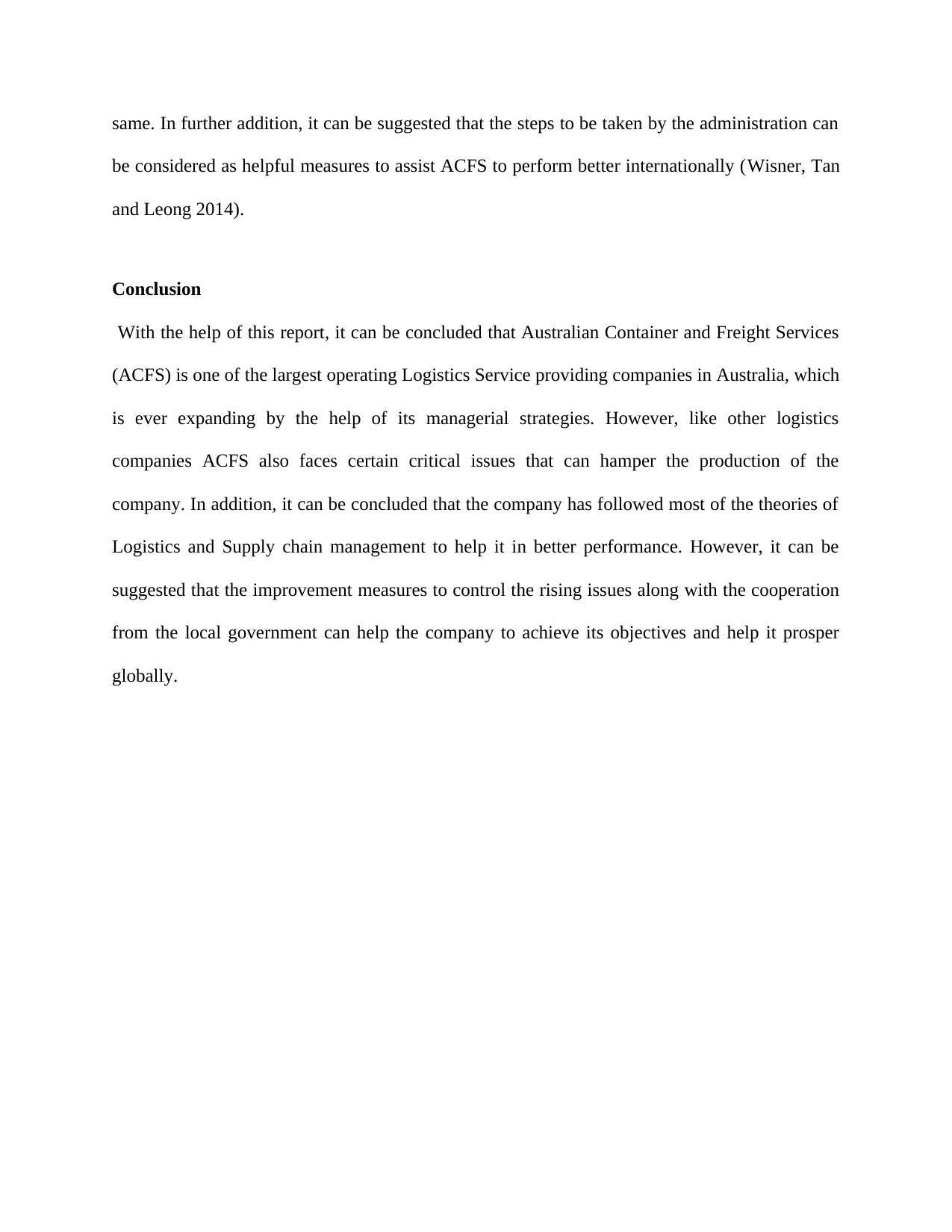
same. In further addition, it can be suggested that the steps to be taken by the administration can
be considered as helpful measures to assist ACFS to perform better internationally (Wisner, Tan
and Leong 2014).
Conclusion
With the help of this report, it can be concluded that Australian Container and Freight Services
(ACFS) is one of the largest operating Logistics Service providing companies in Australia, which
is ever expanding by the help of its managerial strategies. However, like other logistics
companies ACFS also faces certain critical issues that can hamper the production of the
company. In addition, it can be concluded that the company has followed most of the theories of
Logistics and Supply chain management to help it in better performance. However, it can be
suggested that the improvement measures to control the rising issues along with the cooperation
from the local government can help the company to achieve its objectives and help it prosper
globally.
be considered as helpful measures to assist ACFS to perform better internationally (Wisner, Tan
and Leong 2014).
Conclusion
With the help of this report, it can be concluded that Australian Container and Freight Services
(ACFS) is one of the largest operating Logistics Service providing companies in Australia, which
is ever expanding by the help of its managerial strategies. However, like other logistics
companies ACFS also faces certain critical issues that can hamper the production of the
company. In addition, it can be concluded that the company has followed most of the theories of
Logistics and Supply chain management to help it in better performance. However, it can be
suggested that the improvement measures to control the rising issues along with the cooperation
from the local government can help the company to achieve its objectives and help it prosper
globally.
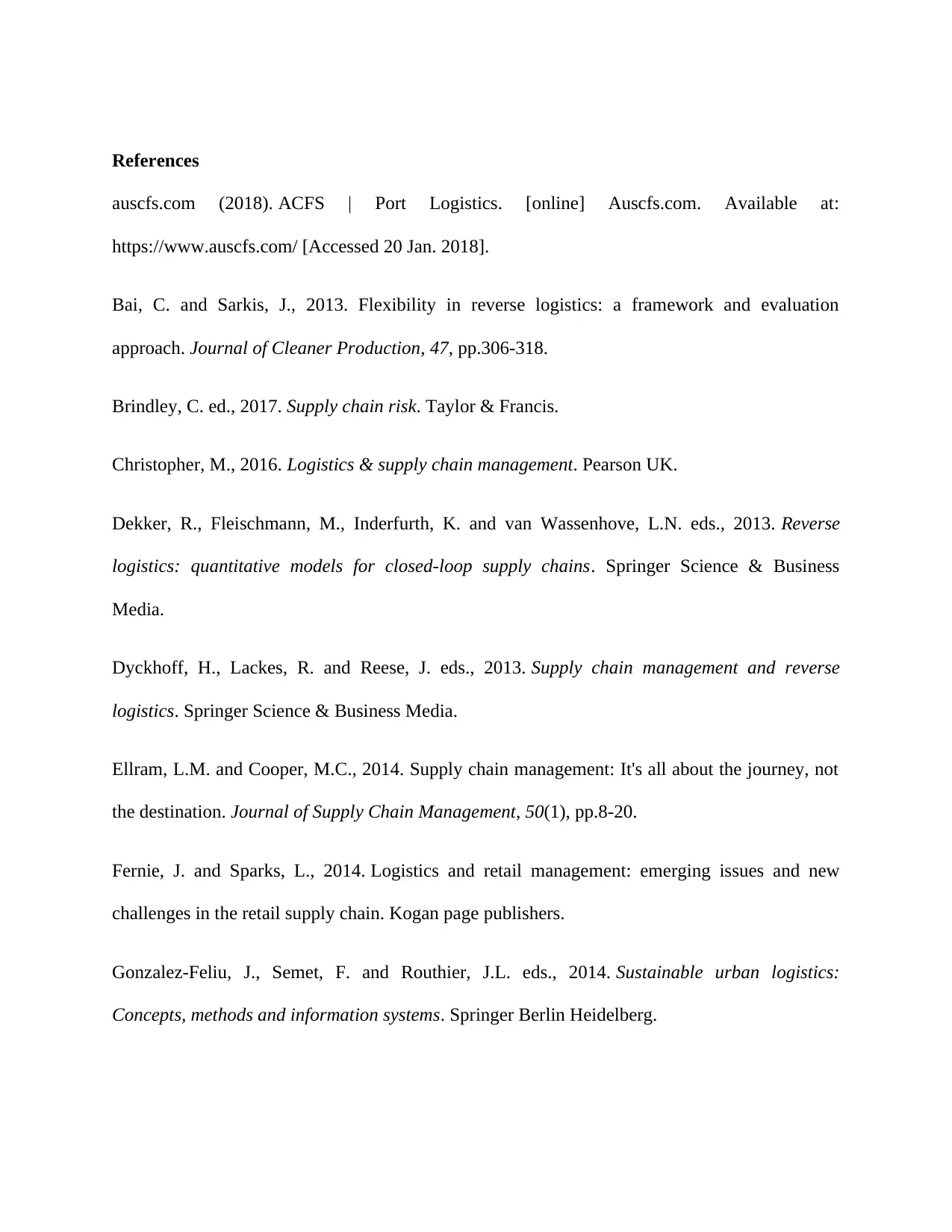
References
auscfs.com (2018). ACFS | Port Logistics. [online] Auscfs.com. Available at:
https://www.auscfs.com/ [Accessed 20 Jan. 2018].
Bai, C. and Sarkis, J., 2013. Flexibility in reverse logistics: a framework and evaluation
approach. Journal of Cleaner Production, 47, pp.306-318.
Brindley, C. ed., 2017. Supply chain risk. Taylor & Francis.
Christopher, M., 2016. Logistics & supply chain management. Pearson UK.
Dekker, R., Fleischmann, M., Inderfurth, K. and van Wassenhove, L.N. eds., 2013. Reverse
logistics: quantitative models for closed-loop supply chains. Springer Science & Business
Media.
Dyckhoff, H., Lackes, R. and Reese, J. eds., 2013. Supply chain management and reverse
logistics. Springer Science & Business Media.
Ellram, L.M. and Cooper, M.C., 2014. Supply chain management: It's all about the journey, not
the destination. Journal of Supply Chain Management, 50(1), pp.8-20.
Fernie, J. and Sparks, L., 2014. Logistics and retail management: emerging issues and new
challenges in the retail supply chain. Kogan page publishers.
Gonzalez-Feliu, J., Semet, F. and Routhier, J.L. eds., 2014. Sustainable urban logistics:
Concepts, methods and information systems. Springer Berlin Heidelberg.
auscfs.com (2018). ACFS | Port Logistics. [online] Auscfs.com. Available at:
https://www.auscfs.com/ [Accessed 20 Jan. 2018].
Bai, C. and Sarkis, J., 2013. Flexibility in reverse logistics: a framework and evaluation
approach. Journal of Cleaner Production, 47, pp.306-318.
Brindley, C. ed., 2017. Supply chain risk. Taylor & Francis.
Christopher, M., 2016. Logistics & supply chain management. Pearson UK.
Dekker, R., Fleischmann, M., Inderfurth, K. and van Wassenhove, L.N. eds., 2013. Reverse
logistics: quantitative models for closed-loop supply chains. Springer Science & Business
Media.
Dyckhoff, H., Lackes, R. and Reese, J. eds., 2013. Supply chain management and reverse
logistics. Springer Science & Business Media.
Ellram, L.M. and Cooper, M.C., 2014. Supply chain management: It's all about the journey, not
the destination. Journal of Supply Chain Management, 50(1), pp.8-20.
Fernie, J. and Sparks, L., 2014. Logistics and retail management: emerging issues and new
challenges in the retail supply chain. Kogan page publishers.
Gonzalez-Feliu, J., Semet, F. and Routhier, J.L. eds., 2014. Sustainable urban logistics:
Concepts, methods and information systems. Springer Berlin Heidelberg.
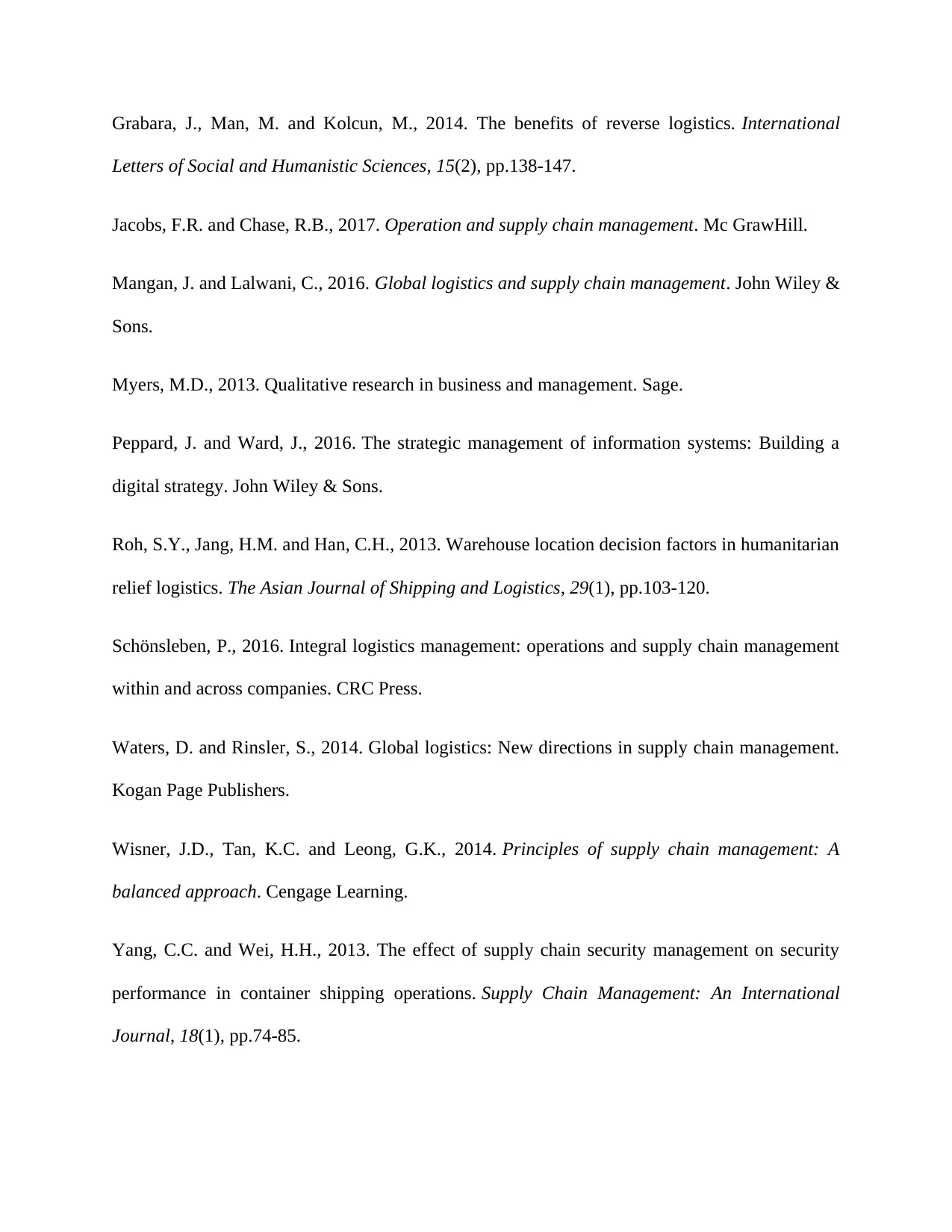
Grabara, J., Man, M. and Kolcun, M., 2014. The benefits of reverse logistics. International
Letters of Social and Humanistic Sciences, 15(2), pp.138-147.
Jacobs, F.R. and Chase, R.B., 2017. Operation and supply chain management. Mc GrawHill.
Mangan, J. and Lalwani, C., 2016. Global logistics and supply chain management. John Wiley &
Sons.
Myers, M.D., 2013. Qualitative research in business and management. Sage.
Peppard, J. and Ward, J., 2016. The strategic management of information systems: Building a
digital strategy. John Wiley & Sons.
Roh, S.Y., Jang, H.M. and Han, C.H., 2013. Warehouse location decision factors in humanitarian
relief logistics. The Asian Journal of Shipping and Logistics, 29(1), pp.103-120.
Schönsleben, P., 2016. Integral logistics management: operations and supply chain management
within and across companies. CRC Press.
Waters, D. and Rinsler, S., 2014. Global logistics: New directions in supply chain management.
Kogan Page Publishers.
Wisner, J.D., Tan, K.C. and Leong, G.K., 2014. Principles of supply chain management: A
balanced approach. Cengage Learning.
Yang, C.C. and Wei, H.H., 2013. The effect of supply chain security management on security
performance in container shipping operations. Supply Chain Management: An International
Journal, 18(1), pp.74-85.
Letters of Social and Humanistic Sciences, 15(2), pp.138-147.
Jacobs, F.R. and Chase, R.B., 2017. Operation and supply chain management. Mc GrawHill.
Mangan, J. and Lalwani, C., 2016. Global logistics and supply chain management. John Wiley &
Sons.
Myers, M.D., 2013. Qualitative research in business and management. Sage.
Peppard, J. and Ward, J., 2016. The strategic management of information systems: Building a
digital strategy. John Wiley & Sons.
Roh, S.Y., Jang, H.M. and Han, C.H., 2013. Warehouse location decision factors in humanitarian
relief logistics. The Asian Journal of Shipping and Logistics, 29(1), pp.103-120.
Schönsleben, P., 2016. Integral logistics management: operations and supply chain management
within and across companies. CRC Press.
Waters, D. and Rinsler, S., 2014. Global logistics: New directions in supply chain management.
Kogan Page Publishers.
Wisner, J.D., Tan, K.C. and Leong, G.K., 2014. Principles of supply chain management: A
balanced approach. Cengage Learning.
Yang, C.C. and Wei, H.H., 2013. The effect of supply chain security management on security
performance in container shipping operations. Supply Chain Management: An International
Journal, 18(1), pp.74-85.
Secure Best Marks with AI Grader
Need help grading? Try our AI Grader for instant feedback on your assignments.
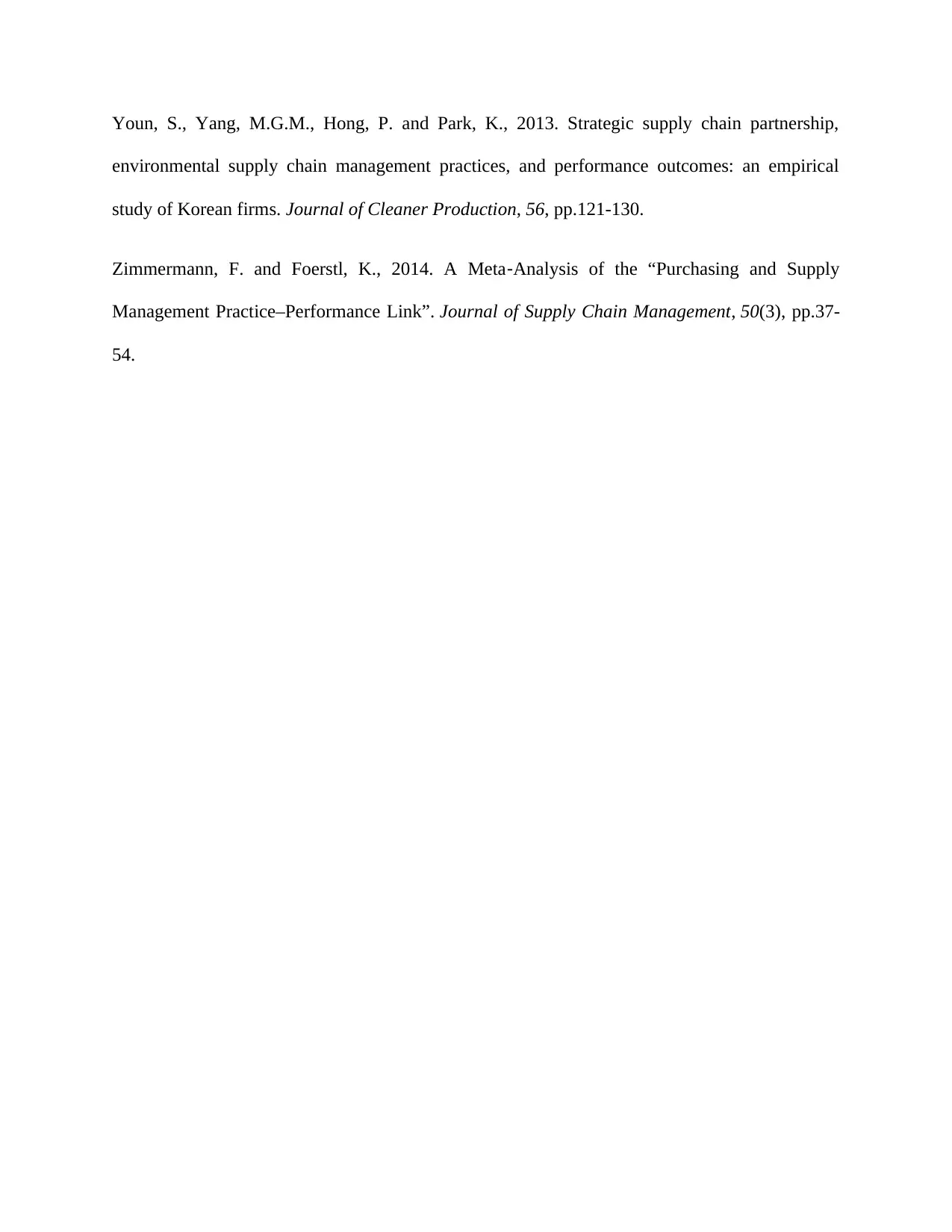
Youn, S., Yang, M.G.M., Hong, P. and Park, K., 2013. Strategic supply chain partnership,
environmental supply chain management practices, and performance outcomes: an empirical
study of Korean firms. Journal of Cleaner Production, 56, pp.121-130.
Zimmermann, F. and Foerstl, K., 2014. A Meta‐Analysis of the “Purchasing and Supply
Management Practice–Performance Link”. Journal of Supply Chain Management, 50(3), pp.37-
54.
environmental supply chain management practices, and performance outcomes: an empirical
study of Korean firms. Journal of Cleaner Production, 56, pp.121-130.
Zimmermann, F. and Foerstl, K., 2014. A Meta‐Analysis of the “Purchasing and Supply
Management Practice–Performance Link”. Journal of Supply Chain Management, 50(3), pp.37-
54.
1 out of 17
Related Documents
Your All-in-One AI-Powered Toolkit for Academic Success.
+13062052269
info@desklib.com
Available 24*7 on WhatsApp / Email
![[object Object]](/_next/static/media/star-bottom.7253800d.svg)
Unlock your academic potential
© 2024 | Zucol Services PVT LTD | All rights reserved.




